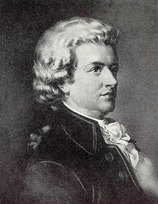 Wolfgang Amadeus Mozart was born in Salzburg on 27 January, 1756, to musical parents. He was a phenomenally precocious child prodigy, a “wunderkind”. Talented at the piano, violin and viola, he had composed over 600 works, including operas, symphonies, and chamber music, by the time of his tragically early death at the age of thirty-five. He was friends with Haydn, a protégé of C.P.E. Bach and an inspiration to many, including Schumann and Mendelssohn.
Mozart lived during the “age of enlightenment”, when Rousseau was encouraging his fellows to cast off their chains and Thomas Paine was developing his “Rights of Man”. There was a new interest in free intellect and introspection. Mozart’s instrumental music was particularly reflective, prescient of Romantic music. While this was a fertile and creative time, patronage of the arts was in decline. The Hapsburg ruler Joseph II’s focus was firmly on socio-political priorities, and pecuniary difficulty was a common theme throughout Mozart’s life. Unlike Haydn, who benefitted from a long-term relationship with his patrons, Mozart had a tumultuous relationship with supporters and his livelihood was based in his performance skills.
The Rondo for Violin in C major, K. 373 was composed in April, 1781, shortly after Mozart took up permanent residence in Vienna. The epitome of stile gallant, the rondo is Allegretto grazioso, moderately fast and graceful, aristocratic and elegant. It was almost certainly composed for Antonio Brunetti, the celebrated Italian virtuoso violinist, although, in a letter to his father, Mozart referred to Brunetti as “a thoroughly ill-bred fellow”.
At first glance, the Rondo appears to be a simple piece with little complexity or musical depth. Unlike typical classical rondos, however, Mozart developed the form into the “sonata rondo”, with a plethora of melodic themes in just 182 bars. Floyd Grave’s analysis captures this:
“..the complementary phases of sonata- form exposition and recapitulation on the one hand, and the rondo’s customary rhythm of alternation between a tonic-key refrain and spans of intervening contrast on the other... Mozart manages to dovetail these two disparate principles, but also to confront the fact of their basic incompatibility ...he often seizes on that very incompatibility and derives from it a compositional resource of vast possibility. In essence, the friction generated by the simultaneous unfolding of sonata and rondo serves him as a foundation for strokes of surprise, suspense, and the wit of unsuspected relationship—and also, perhaps paradoxically, as a source of structural cohesion.” (Grave, “Mozart’s Problematic Rondos”)
The origin of the Rondo for Flute in D major, K. Anh. 184 is unclear, but it is almost certainly later than the violin work that it imitates. The two works are virtually identical. The flute cadenza is now written out, attributed to Jean-Pierre Rampal who was instrumental in popularizing the work. The violin rondo includes dual octave leaps where the flute version has just a single octave. The ending in the last bar is inverted - the violin finishes high on what would be the flute’s fourth octave C, while the flute finishes low on second octave D, a much more pleasing note.
It is a commonplace that Mozart disliked the flute, probably because of its unreliable tuning. He lived during a time of change and experimentation, when there was a moving away from the one-keyed baroque flute to innovations such as Quantz’ tuning slide, and Trömlitz’ new flute in which “in which each of the twelve semitones of the chromatic scale was produced by a separate tone hole not shared by any other note”. The Trömlitz flute’s pure (rather than tempered) intervals were in keeping with Mozart’s ideas on tuning. While Mozart’s flute music is gorgeous on modern concert flutes, arguably the Trömlitz flute is required if we are to play Mozart’s music as he himself would have intended.
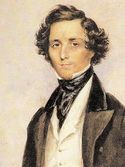 Felix Mendelssohn was born in Hamburg in 1809, into a cultured, educated and affluent family. During a life cut short at 38, he created a huge body of work ranging from concerto’s, chamber music and incidental music, through oratorios, lieder and symphonies. He was a child prodigy who played several instruments, began composing at a young age, and is considered by some to have been even more gifted than Mozart.
The Violin Concerto in Em, Opus 64, is one of Mendelssohn’s most well-known works and one of the greatest violin concertos ever composed. Written over several years, it was first performed in 1845 and by its dates belongs to the early Romantic period. This concerto, however, is more reminiscent of Mozart than Liszt or Chopin, with its relatively small orchestra, no trombones and no separate cello part.
The first movement begins with 1 1/2 bars of tremulous strings and sustained woodwinds, heightening the anticipation of the solo violin’s innovative early entrance with the first lyrical subject. The elegance and lightness of touch often associated with Mendelssohn is there, as well as a gracious relationship between soloist and orchestra, each getting their share of the attention. The transition to the second subject has it’s own theme, this time introduced by the orchestra and then followed by the soloist. The second subject sees another reversal of roles, initiated by a woodwind “choir” with the solo violin becoming accompanist.
Mendelssohn’s written-out cadenza is another innovation, placed before the recapitulation rather than, as was more common, at the end of the movement. The cadenza demands serious violinic skill but Mendelssohn abhorred ostentatious virtuosity, viewing it as vulgar and deleterious to the music. With the placement of the cadenza in the middle, the first movement is able to flow into the second through a single note held by the bassoon. Unlike Vivaldi, for example, who encouraged audience response between movements, Mendelssohn intended the three movements of the Violin Concerto in Em to be played through without pauses between movements, enabling the audience to hear the transitions from the E minor first movement, to the the C major second movement, and the E major final movement. The whole concerto can then be seen as a musical thought. Mendelssohn’s close association with Goethe is well known, and the way in which the final movement contains antecedents from the first comprises a sort of Goethean organic development.
Mendelssohn was hugely popular during his lifetime and also renowned for his prowess as a conductor. His audience tended to be based in the German Bürgertum, the educated and cultured urban who supported the arts and had initiated a shift from purely aristocratic patronage. Mendelssohn was also the driving force behind the creation of the Conservatorium of Music at Leipzig, which became the model on which music education is still based in Germany today.
Since then, however, the social and political context of Germany has had an ongoing impact on the popularity of his music. Sadly, despite his prodigious talent, Mendelssohn’s enduring success has been inextricably meshed with the question of his Jewish background. Wagner’s allusions to a Jewish conspiracy in music became damaging rhetoric in the hands of the Nazis. There was also a feeling, more prevalent in Germany than elsewhere, that Mendelssohn was a lightweight whose familial affluence had precluded him from experiencing the angst necessary to reach greatness. Surely the brilliance of his music should rise above all these other issues but even today, for Felix Mendelssohn, social context continues to draw an uneven interest.
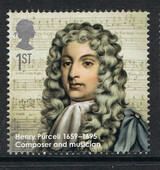 Henry Purcell's Dido and Aeneas has been my next research project. When I first heard the opera, I wasn't at all sure that I would enjoy it, but after all the work analysing it, I'm a real fan.
Henry Purcell was just an infant when Charles II was invited back to England, and in his mid-twenties when James II succeeded to the throne in 1685. He trained as a choir boy at the Chapel Royal, and went on to become a court composer, the organist at Westminster Abbey, and a renowned harpsichord player and teacher before his untimely death at the age of 36.
Dido and Aeneas was Purcell’s first opera and seems to have had little initial impact. After an early amateur performance at Josias Priest’s Board School for girls in 1689 (although it is unclear whether it was performed at Court previously), Dido and Aeneas remained unpublished until 1841.
The opera is in three acts. Act I opens with an Overture based on the French overture form of a slow start followed by a fugal second part. Lovely arias including “Shake the cloud from off your brow”, and “Ah Belinda, I am press’d with torment” are interspersed with choruses and “recitatives” (speech-like solo singing). The first act concludes with an uplifting chorus “To the hills and the vales” followed by an enchanting instrumental dance, “The triumphing dance”.
Behind Purcell’s beautiful music and Nahum Tate’s libretto setting of the Aeneid, lies a world of political uncertainty, constitutional upheaval and social critique. The opera is full of characters who give or receive bad advice, all of it ultimately shown to be ill-considered and misguided.
There is controversy around the dating of the work. Those who date it before the Glorious Revolution of 1688, suggest that Dido and Aeneas is a political allegory, critical of the breakdown of constitutional principles and the subsequent undermining of the divine right of kings. If dated at 1689, Dido and Aeneas can be viewed as a criticism of the new monarchs, Dutch William of Orange, and his wife Mary, the daughter of the deposed James II. It may even be a warning to William to treat Mary well. Either way, Dido’s death is unusual and foreboding in an opera of the period, and coincided with Purcell’s declining popularity in the new Court.
Musically, Dido and Aeneas demonstrates Purcell’s genius. He was skilled at “word painting”, using music to embody meaning, as for example the dissonance when Dido sings “Peace and I are strangers...”. Purcell did not create word painting, it was frequently used in Elizabethan and Baroque music, but he was a master at it. Similarly, he had a gift for English prosody, accurately recreating the rhythms of the English language in his music.
Purcell also showed extraordinary talent in the way he employed musical keys to underlie the drama. Most of the opera is in C minor, which represents pain and suffering. Happier scenes, such as the lovely “Fear no danger” duet and chorus are set in C major, the “royal” key. F major is Purcell’s love key and G minor is his death key, used as foreshadowing in “Ah Belinda” and then towards the end of Act III in “Dido’s Lament”.
Over two hundred years after Purcell composed Dido and Aeneas, a group of music students, including the young Ralph Vaughan Williams and Gustav Holst, were instrumental in reviving the opera for the 1895 bicentennial of Purcell’s death. Today, it is still frequently performed and recorded. Henry Purcell’s Dido and Aeneas may have been ‘just’ a small opera, but it continues to illuminate a watershed in English history and is cherished as early English music.
"Without music, life would be a mistake."
Friedrich Nietzsche
In December, I was privileged to to be the soloist in the Prelude movement of John Rutter’s Suite Antique, played by the Stevenson String Group. Three flute players each took one movement.
I confess to having more than a few qualms when I learned that my movement was the Prelude, especially about the middle high section. I must have practiced that fast motif at least a thousand times, quite a few of them unsuccessfully. In the end, an adjustment to my left wrist position and a lot more practice ensured it came off on the night.
While last year, I felt very nervous performing, I seem to have become more confident, especially when I feel prepared enough. In the December concert, while there was a moment of inattention and improvisation, I felt in control of my flute and the music, and that was a great feeling. It was also amazing to perform as a soloist, and to work closely with a conductor and accompanist! I may never get an opportunity like that again, but it was so wonderful to be standing up on the stage, playing, with an orchestra at my back!
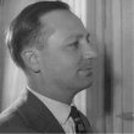 Last week, for my Performance Assessment, I played the Rutter with piano accompaniment followed by Pal Jardanyì’s Sonatina for flute in three movements.
Pal Jardanyì was born in Budapest in 1920. (My maternal grandparents were also Hungarian, but they left Budapest at the turn of the century, emigrating to the US.) Jardanyì was a pupil of Kodaly, an avowed anti-fascist who assisted and sheltered Jews during WWII, and a supporter of the 1956 Hungarian Uprising for which he was subsequently dismissed from his position at the Academy of Music in Budapest. He was interested in ethnomusicology, and in 1960 became Head of the Department at the Folk Music Research Group, Hungarian Academy of Sciences. He was only 46 when he died.
The Sonatina for flute was written in 1952 for the Hungarian flautist Zoltan Jeney. It’s a lovely, expressive work with several changes of mood packed into a short piece. Originally, I felt it might be too modern for me to relate to, but I have thoroughly enjoyed playing it. It’s been a kind of journey towards understanding the music, finding meaning and then expressing that meaning. In my mind, there are themes of the end of WWII, sadness, and regeneration. It amused me, therefore, to accidentally discover, only on the day of the performance, that the Sonatina is subtitled in Hungarian, “Hajdu” translated as “Hungarian Herding Songs”. I wonder whether knowing that would have changed my approach?
While overall I've been pleased with my performances, I know that I have a tendency to become sharp when playing loudly, and I need to learn how to project my sound more. That's what I'll be working on over the next few months.
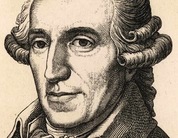 I'm studying classical music research and analysis techniques this year - very exciting stuff. For the first assignment, I focussed on the 3rd, Allegro, movement of Haydn's Trumpet Concerto in E-flat Major, Hob. VIIe: 1. I have always liked Haydn, and it's been really interesting to look at the music from a more rigorous perspective, and to learn about the development of the trumpet.
Franz Joseph Haydn was born in Austria in 1732, the year that Benjamin Franklin began to publish his Almanac a continent away. Haydn spent much of his adult life as musical director to the Hungarian Esterhazy Princes, living through the French Revolution, the American Revolutionary War and the rise of the Industrial Revolution. Like Handel, he spent time in London and was much loved by the British people. He was Mozart’s friend, Hummel’s mentor and a prolific composer. Haydn died in 1809, leaving behind nearly 500 works, including some 108 symphonies and 17 concertos. The Trumpet Concerto in E-flat Major (Concerto per il clarino, E flat) was the last concerto he wrote.
In his sixties, with an established international reputation and an Honorary Doctorate from Oxford, Haydn composed the Trumpet Concerto in E-flat Major specifically for the new “organised” (or keyed) trumpet. Anton Weidinger, perhaps the most virtuoso trumpeter of his day, had invented this trumpet in order to broaden the technical and artistic range of the E flat trumpet. Previously, the Baroque trumpet’s chromatic scope had been limited to the upper two octaves, known as “clarino” (clarion) playing, with much playing done in the more normal court or military “principale” range. By the end of the 18th century, clarino technique had all but died out, with the trumpet relegated to military fanfare use, or solely as a member of the orchestra. It was hoped that Weidinger’s keyed trumpet would enable a fuller chromatic range as well cantabile expression.
The Trumpet Concerto in E flat, composed in 1796 but not performed until 1800, ushered in a new repertoire for the trumpet. It is widely suggested that the reason for the four year delay before the first performance was due to Weidinger’s need for ample time to learn the new instrument and be able to play the solo part. While this concerto is one of Haydn’s most well-known works today, it made little impact at it’s debut and was then lost until 1929. Similarly, Weindinger’s innovation failed to endure although it did lead the way to the valved trumpets still played today.
Movement III, Allegro opens with the orchestra playing a compelling and memorable melody that is recycled throughout the work. This melody is then taken up by the solo trumpeter, with the orchestra acting as accompaniment. For today’s audiences, used to hearing modern trumpets, the simplicity of the main theme masks the extraordinary technical advances made possible by Weidinger’s trumpet. Haydn alternates between military rhythms recalling the trumpet’s previous role, and virtuoso displays including octave leaps, innovative changes of key, and chromatic scale and trill passages comprised of notes that could not previously have been played. At the end, the soloist returns to the trumpet’s lower principal range, almost as if to suggest that all the pyrotechnics were just an illusion, and it’s just an ordinary trumpet, after all.
I’m back at college again, but part-time this year... although the workload feels like full-time, and I don’t know how the others are managing. For me, the learning is an end itself. Having been a proponent of lifelong learning when I worked in adult learning in Perthshire, it’s thrilling to be a lifelong learner myself, and in theory, this should be enough. I’m too old to be looking towards full-time employment in music, but it amuses me that I’m not too old to still have aspirations and ambitions. I had planned to apply to do a BA in Music, but I’m so enjoying the opportunities at Edinburgh Colleges (Sitehill Campus, formerly Stevenson College), and being part-time gives me a better study / home balance at this stage in my life.
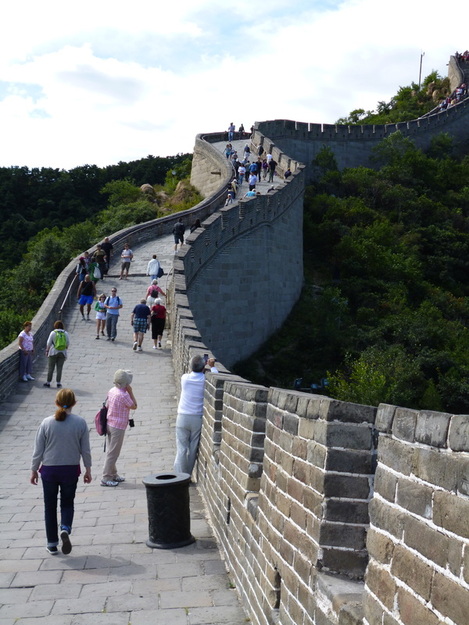 I’m taking a break from playing traditional music in order to focus on improving my Boehm flute playing, and this has caused me to reflect and stress on what I want out of my music, and where I’m going. It seems to be a pattern - I work hard, just get to the point where I’m near the top of my game, and then I decide to start another instrument, or in this case, play a different genre. An old trad flute friend phoned this weekend, someone with whom I have played in sessions and met up with in workshops for over a decade. She’s now playing both Boehm and wooden flutes, as is another acquaintance. Perhaps, for traditional flute players, Boehm flute is the natural progression, being a more optimized instrument with more tone opportunities and a bigger range. Perhaps I really do have a low boredom threshold? Maybe it’s just that music is the journey and there always will be times when it feels right to move on... (one of the most exciting journeys I've ever had was walking on the Great Wall in China recently).
Or perhaps it’s as Peter Marino, the architect said recently: “...go around the middle: go above or below. People who are massively insecure want to be in the middle. It makes them feel safe. It doesn't make me feel safe. I can't breathe” (Peter Marino talks to Vanessa Friedman, Lunch with the FT, 29 September 2012). Right now, playing the Boehm flute feels like a new chance to breathe.
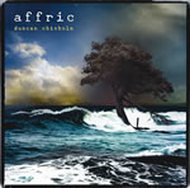 Duncan Chisholm’s concert at the Queen’s Hall last Friday, with the launch of his new cd Affric, is the culmination of a very personal journey of exploration through the ancient Chisholm Clan lands. He played selections from all three of the Strathglass cd trilogy (Farrar, Cannaich and Affric), bringing his unique mastery of beautiful tone, lyrical playing and driving rhythm. A couple of the trad concerts I’ve been to recently have been very “same old” or even past their sell-by date, but I could listen to Duncan Chisholm every week and still be mesmerized by the sheer beauty of his playing. He opens a window into his soul in his slow playing while in his fast playing, he move as easily onto the off-beats as the downbeat, and it gives the music lift and drive. There were times when I could would have liked to get up and dance, and there were times when I could have wept. A great evening to remember.
I’ve booked myself in for the ABRSM Flute 6 exam in November, very scary as I’ve never done an ABRSM practical exam before. I’m looking forward to attending a Syrinx Flutes workshop soon, organized by the SCO’s Lis Dooner, then a chamber music weekend in Birnam at the end of the month. I’m also very excited about playing part of John Rutter’s Suite Antique with the string group, so beautiful...bits bring Peter Warlock to mind. So much to do... so little time.
I can’t tell you how many times I “intended” to write a blog this summer that’s now just past. I would find myself in concerts, reading reviewing, grappling with classical music, thinking: “ I should write a blog about this”. But by the time I actually sat down at my laptop, it always seemed less immediate, or perhaps too formulaic - reporting on events rather than reflecting on experiences.
There was the opening concert of the Edinburgh International Festival, Delius’ Mass of Life at the Usher Hall. I so wanted to experience the opening concert, and had high expectations, despite my better half’s protestations. In fact, we both found the work inscrutable and were amused to hear the elderly concert-goer behind us comment to her friend: “He must have been on drugs!" The lesson for me is that choosing concerts, like wine, requires more thought than the title of the work or the colour of the label! Since then, I’ve watched a very interesting BBC documentary on Delius, and am enjoying a burgeoning relationship with some of the more melodic works.
I also spent a few enjoyable but challenging days at the Scottish International Flute School , held at St. Leonard’s School in St. Andrews. So much wonderful flute repertoire! As a result, I’ve been dipping into Aaron Copland’s Duo for Flute and Piano (some ideas very evocative of Appalachian Spring), the Poulenc Flute Sonata and CPE Bach’s Sonata in G minor. Wissam Boustany’s concert was passionate and inspiring, and the vision of how he breathes will stay with me and influence my own playing. Ian Clarke’s concert was astounding, in the way he feels the rhythm of the music, and in his circular breathing, which I have heard of and discussed, but never seen put into action before. Lis Dooner was such fun to work with, and so helpful in our chamber group. I met so many lovely flute players, and many thanks to Yvonne Paterson who organizes it all!
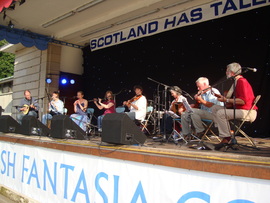 © Corinne Clarke At the end of July, I played with Shindiggery on the Ross Bandstand as part of the Scottish Fantasia “month long celebration of Scottish musical talent”. It gave me the opportunity to borrow and try out mic’ing the flute with a swan neck mic and the concertina with a similar mic centered over the bellows. While it was very satisfying to play mic’d, the band’s sound wasn’t balanced - for a large band like ours, there just wasn’t enough time allowed for a proper soundcheck and adjustment. I also got together a smaller group, MacReedie, for a small gig at the Spiegel Terrace on George Street. Four of us (smallpipes, whistles, melodeon, mandola, flute and concertina) spent a couple of hours playing together - lovely sound, just a pity about the weather... cold and rain made for a small audience. Unfortunately, timetable conflicts this year mean I'll be taking a break from Shindiggery.
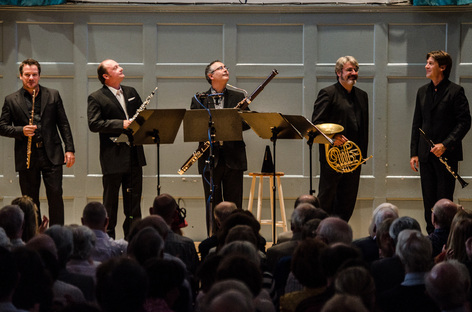 © The Queens Hall, Edinburgh The wind quintet, Les Vents Français’, concert at the Queen’s Hall was a real high spot, as was their talk at the Hub later that afternoon. Their music, they said, came out of their friendships over the breadth of their careers, a long conversation that changes over time. Their performances are very much of the moment, with things happening spontaneously out of listening to each other.
Malcolm Martineau’s talk about music and accompaniment was similarly inspiring. I was interested to hear that his musical education focussed first on being expressive, with technique coming later (similar to my own experience, although I am only now really grappling with technique). He repeatedly referred to how much fun he has with music - so lovely.
I’ve just started back at Stevenson College as a part-time student, focussing on classical music, flute, theory and composition. It all feels very “grown-up” and I’m so excited about what we’ll be learning this year. The music faculty at Stevenson is so welcoming and so responsive - I’m very luck to have these opportunities on my doorstep in Edinburgh (okay, well not exactly on my doorstep, but only two bus journeys away).
So, at the end of the summer, I have new goals. Developing my classical flute technique is paramount, as well as furthering my understanding of classical music forms, context and theory . I so want to be part of a small chamber ensemble - it’s a question of finding like-minded people to play with. If it’s meant, it will happen. (But if you’re reading this and have similar aims, get in touch!
|









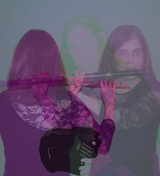
 RSS Feed
RSS Feed